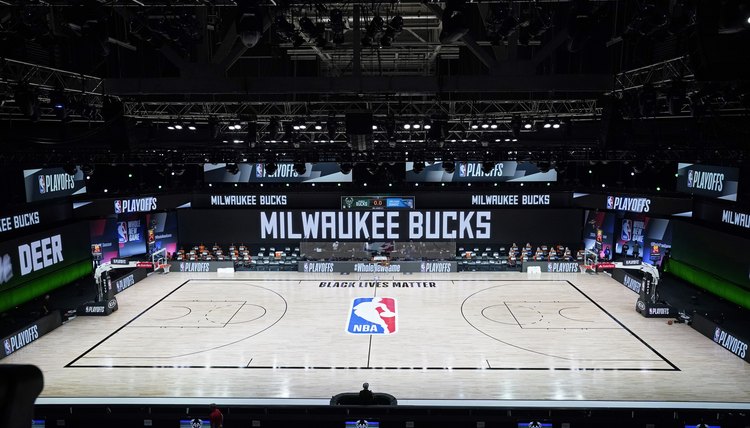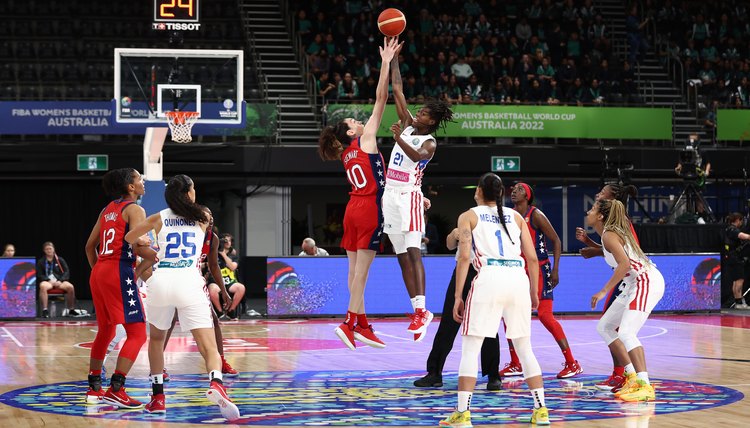NBA Basketball Court: Know the Parts of the Basketball Court

Taking a look at a basketball court for the first time can leave you confused, but once you understand what all of the end lines and restricted areas mean, it can be pretty simple to understand. For starters, the basketball court is divided into two equal sides with the same features and court dimensions. Each line on one end of the court is present on the other, and they all have the same meaning no matter what side they lie on.
Free Throw Lane
The free throw lane is a rectangle in a team's frontcourt and used to line up players during a free throw. The player shooting the free throw stands at the top of the lane at the free-throw line, while other players stand in marked spots along each side of the lane.
On offense, players may not stand in the free throw lane for more than three seconds unless they are making a move to the basket with the ball. In an NBA basketball game, defensive players may not be in the lane for more than three seconds unless they are actively guarding an offensive player. The free throw lane is sometimes referred to as the “paint” or the “key.”

Three-Point Line
The three-point line is a semicircle that surrounds the basket area on each team's side of the court. Players who stand behind the line and make a field goal are given three points instead of the standard two points for a regular field goal.
Sidelines and Baselines
The sidelines and baselines of a basketball court mark the outside boundaries for out-of-bounds purposes. The sidelines run the length of the court and the baselines are behind each basket.

Center Circle
The center jump circle is where the game action starts with the jump ball. All players other than the two jumpers must stand outside the circle until the ball is tipped. The center jump circle is not used at any other point in the game other than the opening tip and if a tip is needed to start an overtime period. Two jump circles located at the free throw line are used in the NBA for held ball situations.
Division Line
The center court line, or midcourt line, is a line running the width of the middle court that divides it into two equal sections. In high school and college, a team has 10 seconds to get the ball across the halfcourt line, while in the NBA, the time requirement is eight seconds.

Basket
The basket -- one on each end of the floor -- is made up of a backboard and a ring that holds a net, which is designed to check the ball as it passes through the basket.
Basketball Court Size and Dimensions by Playing Level
High school basketball court
- Free throw lane: 15 feet from the center of the backboard, 19 feet long, 12 feet wide
- Three-point line: 19 feet and 9 inches from the center of the basketball hoop
- Overall court size: 50 feet wide, 84 feet long
NCAA Court Dimensions
- Men’s college basketball three-point arc: 22 feet, 1 ¾ inches
- Women’s college basketball three-point arc: 22 feet, 1 ¾ inches
- Court length and width: 50 feet wide, 94 feet long
National Basketball Association Court Dimensions
- On an NBA court, the 3-point line measures 23 feet, 9 inches from the hoop at the top of the arc and 22 feet at the sidelines
- Overall court dimensions: 50 feet wide, 94 feet long
Women’s professional basketball (WNBA) Court Dimensions
- Three-point line: 22 feet, 1.75 inches
- Overall playing surface: 50 feet wide, 94 feet long
International Basketball Federation (FIBA) Court Dimensions
- Three-point line: 20 feet, 6 inches
- Overall playing area: 91 feet, 10 inches long and 49 feet, 2.5 inches wide
On any basketball playing surface, regardless of the level of play, the free-throw line is 15 feet from the center of the basket
The standard basketball backboard is 72 inches wide and is positioned 4 feet inside the baseline. The hoop, or ring, stands 10 feet off the floor and is 18 inches in diameter. Center circles on a basketball court typically have a radius of 6 feet.
References
Writer Bio
James Patterson specializes in health and wellness topics, having written and produced material for the National Institutes of Health, the President's Cancer Panel and an Inc. 500 Hall of Fame company. He is also a former sportswriter with writing experience in basketball, baseball, softball, golf and other popular sports.
